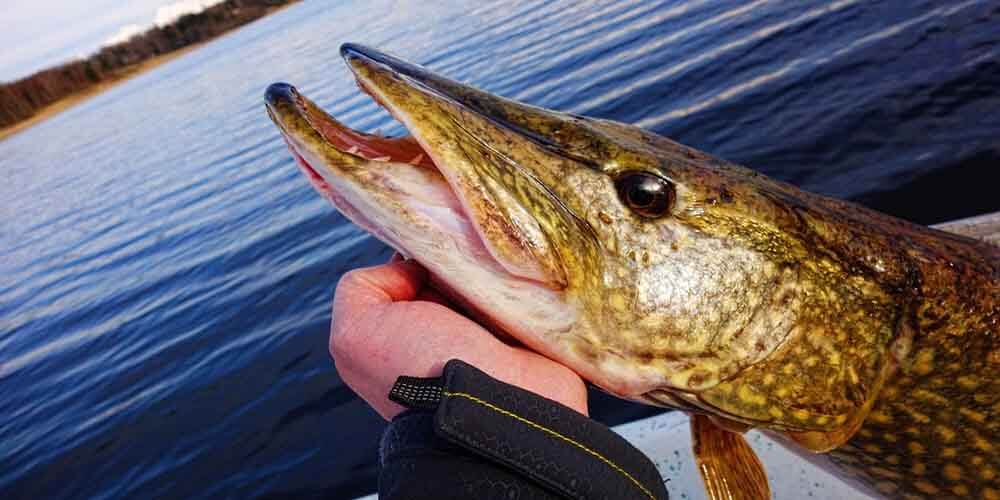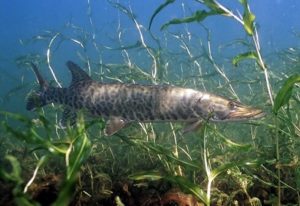Muskie Fishing Tips

Where should I go for the best shot at catching one? What equipment is best for it? When are they most active?
The muskie is one of the most sought-after freshwater fish by North American anglers. Fast and strong, and also elusive, it is “the fish of ten thousand casts.” Being elusive hardly makes it an impossible catch, however.With the right knowledge and techniques, even a novice fisherman can go out on the water with confidence that he can and will land his first muskie.
Whether you are indeed a beginner, or if you’re already a seasoned hand with a fishing rod, that confidence is exactly what I hope you’ll get out of this article. Here we will cover some basic muskie fishing tips from experts who themselves have caught many of these impressive creatures.
About Muskie
Muskie (or musky) is a shortened nickname for muskellunge (scientific name: Esox masquinongy), a large North American freshwater fish. It is, in fact the largest member of the pike family, and it is also rather uncommon, though not endangered. Muskies are light brown, with pattern that can be described as spotted or barred. They typically range in size from 28 to 48 inches long, weighing around 15 to 36 pounds.

Their habitat includes the major rivers and clearer small lakes surrounding the Great Lakes region of the United States and Canada, ranging from as far northwest as Manitoba to as far south as Chattanooga, Tennessee. They also have been introduced to some waterways in the U.S. state of Maine.
They are the natural apex predators of their habitat, hunting and feeding on prey that can be as long as 30% of their own body length. That prey is usually any number of smaller fish species, it can also include more unusual fare such as “crayfish, frogs, ducklings, muskrats, mice snakes and other small birds or mammals.”
The waterways they most often prefer are rocky and clear. They tend to stick to the shallower areas where they can hide and rest beneath rock outcroppings and weeds. Rarely will they venture beyond 40-foot water depths, and their preferred water temperature for spawning is between 50 and 60 degrees Fahrenheit. Their spawning areas are most often rocky or gravelly, and around six feet deep, where their slightly adhesive eggs can stay put without sinking in and being smothered by loose sand.
Muskie Fishing Tips, Tricks, and Techniques
Catch-And-Release Versus Keeping
If you want to catch muskie and keep it, the best place to do that is most likely Maine. Muskie is not a natural inhabitant of that state’s waterways, having been introduced there in the late 1960s, starting in the western Saint John River. In that state, where they are considered an invasive predator species, anglers should not return any caught muskie back into the water.In contrast, many other areas where muskie are naturally found are highly concerned with overfishing and habitat destruction, and so they often require catch-and-release of muskie in addition to their hatchery programs. Make sure to bring a good camera!
Different-Sized Lures Needed
Muskie generally prefer smaller prey in the springtime, but in the summer and fall they will hunt for larger prey in preparation for the colder and less plentiful winter months. Anglers should adjust their lures accordingly, starting smaller during spring and gradually increasing the size throughout fishing season.
Strong Rods, Wires, and Lines Required
Muskie can be fast and strong, but usually are less maneuverable than smaller fish. When hooked, they will put up a good fight that may include some head shaking and even leaping out of the water. To catch them effectively, the following equipment is recommended:
- 7 to 8 foot long heavy duty pole
- 20 to 25 pound fishing line
- 75 to 100 pound test leader wire
How to Land a Muskie for the First Time
Dave Dorazio, a guide and Field Editor at fishinfo.com, shared his insights into what he considers the six most important factors for a novice fisherman who hopes to catch a muskie for the first time. His expert muskie fishing tips apply generally as follows:
1. Choice of Lake
- Muskies can be found in more bodies of water than ever before, but not all of those bodies are well-suited to actually catching one.
- So-called “trophy” waters have some large muskies, but also a low muskie population density. Catching one there will require putting in a lot of hours, and a great deal of patience
- For better odds, look for “action” lakes instead.
i. Action lakes are smaller than 1000 acres, sometimes less than 500 acres.
ii. Action lakes have a lot of shallow water less than 15 feet in depth
iii. They have a high population density of smaller or medium-sized muskies with a few bigger fish.
- Use lake map books and the internet to find action lakes, as well as by searching local resources. Check with bait shops and with guides during the off
- Dave’s favorite action lakes are shallow, weedy, and have darker or stained water. Some of them are artificial reservoirs behind a dam. In these kinds of lakes, the muskies tend to gather among the weeds along the shore, so their location is easier to figure out (On this point, finandfeather.com notes that “Muskie will still [go] into the thick weeds like Pike, but generally they like to face the open water and have their prey trapped between them and the shore.” See the map provided!
2. Choice of Lure
- Lures that sink fast or run deep will be problematic for fishing among aquatic weeds.
- Dave recommends bucktail and topwater lures. They are straight-running and can be retrieved fast, giving the muskies something they can chase, and allowing the angler to cast more often, which is essential. Muskies require the fisherman to work efficiently.
i. Jerkbaits and twitchbaits can be used, but especially in weedy areas, they require a bit more work.
ii. Dave prefers to avoid walk-the-dog style topwaters, though they may work well for more advanced anglers.
iii. The best bucktail lures are 6 to 8 inches, and are better with two hooks (or more) to increase the odds of hook-ups.
3. Tackle
- Adequately heavy tackle is essential for more consistent ability to set a hook and successfully reel in a big and strong muskie.
- 7 to 8 foot rods are ideal.
- “Match your rod with a round-style bait casting reel,” Dave says, noting that spinning reels and small bass reels make it much harder to retrieve a lure and can’t hold up to the demands of muskie fishing.
- Use superbraid line instead of monofilament, nylon, or dacron. The latter materials are too stretchy, but almost any 50- or 80-pound test superbraid will more easily hook a muskie.
- Make sure to get sturdy wire or fluorocarbon leaders of high quality. “With a good ball bearing swivel and a sturdy snap,” they should cost at least $3, and anything less absolutely won’t cut it.
4. Weather
- The best time to fish for muskie is in advance of an approaching rain and storm front, especially after a long time with sunny and clear weather.
- Hot but briskly windy days are also good for making muskies feel more aggressive.
- The basic rule seems to be that changes in the weather are positives for muskie fishing, and the stronger the change, the better.
5. Timing
- The seasonal peak is different at each lake, but generally the darker and shallow lakes peak early, whereas the clearer deep lakes peak later in the season.
- To know a lake’s peak productivity, you need to either fish it consistently, or ask someone else who does. Bait shops may be able to provide this information.
- Be aware of daily peaks and minute changes in activity caused by light levels and the weather. Dawn and dusk are reliable times to go fishing for this reason.
6. Attitude
- Anglers think positively, or else they self-defeat! Just because you haven’t caught one yet doesn’t mean it won’t happen soon.
- Concentrate on making each cast productive. Take short breaks when necessary to restore concentration.
- Dave says, “I like to remind myself that the only reason I didn’t catch a musky on a cast is because the fish was waiting for my next cast!”
Final Verdict
Stick to the shallows, right where the weeds start to thin out and big rocks give way to gravel. That seems to be the consensus view as to where you are most likely to find an active and hungry muskie, ready to be hooked and reeled in. It’s essential to know the lakes themselves, and bring along the right stuff- the heavy-duty rods and reels that will hold up to a fight with a strong muskie.
Fish with the rising and setting suns, beating oncoming storms, patiently casting and quickly retrieving. When a muskie finally bites, set the hook and wear it out. Fight and bring it in, and proudly know that after absorbing these muskie fishing tips, you came prepared to do so.
We like to share product recommendations with you and hope you like them! Just to make you aware FishingLab may collect a small share of sales or other compensation from the links on this page.
